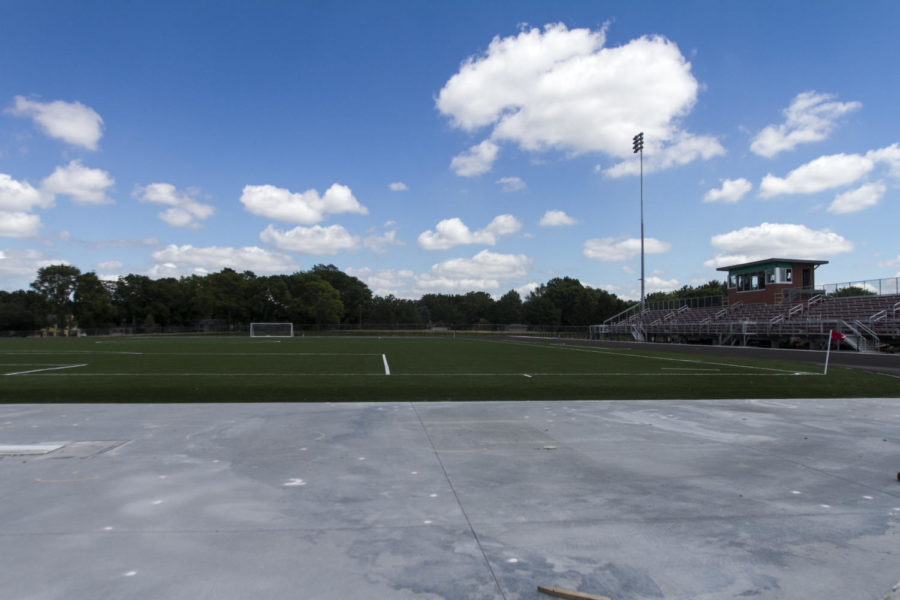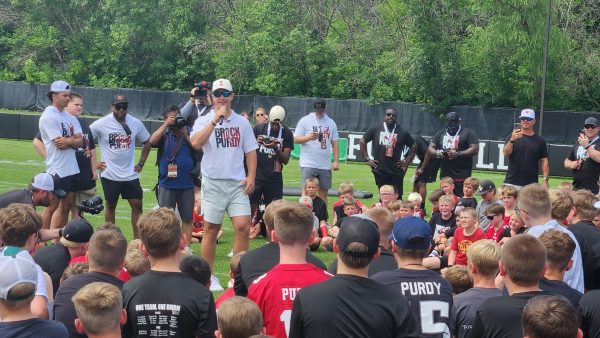Facilities become emphasis for ISU athletic department
August 2, 2012
Dirt still connects the fields, and workers continue diligently on the finishing touches.
Yet with each passing day, the thought of events at the Cyclone Sports Complex becomes closer to reality.
Since the Board of Regents approved the new facility in October 2010, the ISU athletic department has worked to secure funding and lock down details on the 22-acre, $10.7 million project that will bring new soccer and softball fields, as well as a new track and throwing areas.
The project is one of many ongoing developments for the athletic department, as they also continue working on a new football facility and a golf performance facility, as well as remodeling the wrestling practice room at Lied Recreation Athletic Center.
The enhancements help push Cyclone athletics forward.
“It gives… I don’t know if the right word is ‘hope,’ but it fulfills to our constituents what we said we were going to do,” said Athletic Director Jamie Pollard. “They’re proud of that and excited by it, because when they were here, we didn’t have that, so they feel like they were the pioneers to make it happen.”
When Pollard was hired in 2006, he had a plan. Much of it involved the facilities in Ames, and previous enhancements have included the addition of the Sukup Basketball Complex for the men’s and women’s teams and a new scoreboard and sound system at Jack Trice Stadium.
“We had a vision of things that needed to happen,” Pollard said recalling his plan when he first arrived. “Part of it was we needed to sell more tickets; we needed to raise more money. … If we could do that, we showed what we would do to reinvest that.”
Now they are acting on those plans and reinvesting.
The money has flowed in during Pollard’s tenure, and it has been spread across many sports.
When the Cyclone Sports Complex and the new football facility are finished, more than $100 million will have been invested in facilities since Pollard arrived.
While the football facility will aid recruitment for football and help progress that program, Pollard is particularly excited about the Cyclone Sports Complex. The new facility lies about 1 mile east of the Southwest Athletic Complex, the current home of Cyclone softball.
“It’ll help in recruiting significantly because it gives us a front door for those programs,” Pollard said. “For those student athletes that are here, it gives them a better place to train and to become the type of student-athlete they all want to be.”
The ISU soccer team has played at the ISU Soccer Complex behind Lied since the team’s inception in 1995. The softball team has played at the Southwest Athletic Complex since 1980.
Both facilities have sufficed for their respective teams during those periods.
But after the soccer complex was flooded in 2010 — the land it is built on is in a flood plain — it was clear it might be time for improvement.
Both the new soccer and softball fields will seat approximately three times as many fans, said Chris Jorgensen, senior associate athletic director of facilities, planning and management.
Jorgensen estimated that the new complex is about 90 percent completed but said the soccer team will now begin its upcoming season at its old home behind Lied.
“Soccer will begin practicing in their existing facilities at Lied when they start camp in August,” Jorgensen said. “They will play their home schedule at Lied until the Cyclone Sports Complex is available for their use.”
The current goal is to have the softball field ready for practice use when the team returns later in August.
And the complex will provide something for the track and field team, too.
While Pollard does not anticipate an abundance of schedule additions with the new outdoor track, he said Iowa State will now be able to host the Big 12 Championships once every 10 years and better prepare for outdoor meets.
Pollard said the complex would not be possible without several factors contributing to its development, particularly the involvement of the Big 12 Conference.
“It wouldn’t have been possible if we didn’t have the increase in ticket sales and donations,” Pollard said. “Most importantly without the Big 12; if it weren’t for the Big 12 television contracts and the Bowl Championship Series contracts, none of this would be possible.”
Pollard said only the department’s tennis, gymnastics and swimming programs haven’t seen big facility changes yet.
And as Pollard named off the many things on the department’s current slate, he paused, looking toward his window that faced Jack Trice.
“Of course we’ve got everybody’s popular south end zone project that at some point we’ll have kind of re-fired up,” Pollard said.
Yet another project that only seems like a matter of time.
“Hopefully it’ll be done someday -— it’s just a major undertaking,” Pollard said. “That’s just one you don’t embark upon lightly, because you don’t want to put the program at risk by over leveraging it.
“We’ll do that when we feel we can properly fund it without crippling the rest of the programs.”
For now, they will focus on finishing what they have already started.

















